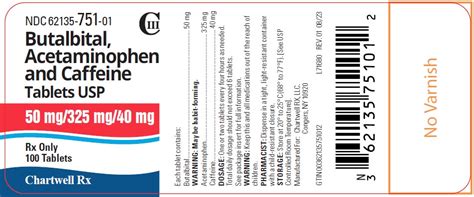Intro
Discover key facts about Butalbital Acetaminophen, a prescription medication combining a barbiturate and pain reliever, used for tension headaches, migraines, and pain management, exploring its effects, dosage, and potential interactions.
Butalbital acetaminophen, a combination medication, is widely used for its analgesic and barbiturate properties. It's essential to understand the components, uses, and potential risks associated with this drug to ensure safe and effective use.
The combination of butalbital, a barbiturate, and acetaminophen, a pain reliever, makes this medication potent for treating tension headaches. However, its potential for dependency and side effects necessitates careful consideration. Users should be aware of the recommended dosage, potential interactions with other medications, and signs of overdose or adverse reactions.
Understanding the pharmacodynamics and pharmacokinetics of butalbital acetaminophen is crucial. Butalbital acts as a central nervous system depressant, while acetaminophen works as an analgesic and antipyretic. Their combined effect provides relief from headache symptoms, including those associated with tension headaches. It's also important to note the differences between butalbital acetaminophen and other pain relief medications, such as those containing codeine or hydrocodone, in terms of efficacy, safety profiles, and potential for abuse.
Introduction to Butalbital Acetaminophen

Benefits of Butalbital Acetaminophen

Working Mechanism
Butalbital acetaminophen works by combining the effects of a barbiturate (butalbital) and an analgesic (acetaminophen). Butalbital acts on the central nervous system to produce a relaxing effect, which helps to reduce muscle tension and alleviate headache symptoms. Acetaminophen, on the other hand, works by blocking the production of prostaglandins, which are chemicals in the body that cause pain. The combination of these two mechanisms provides effective relief from tension headaches.Risks and Side Effects

Precautions and Interactions
When taking butalbital acetaminophen, it's essential to be aware of potential interactions with other medications and to take precautions to minimize risks. Individuals with a history of substance abuse or those taking certain medications, such as sedatives or antidepressants, should use caution when taking butalbital acetaminophen. Additionally, this medication should not be taken with alcohol or other central nervous system depressants, as this can increase the risk of adverse effects.Usage and Dosage

Alternatives and Comparisons
For individuals who experience side effects or have concerns about the potential risks of butalbital acetaminophen, there are alternative treatments available. These can include over-the-counter pain relievers, such as ibuprofen or aspirin, or prescription medications like triptans or ergots. It's essential to discuss these options with a healthcare provider to determine the most effective and safe treatment plan.Long-Term Effects and Dependency

Withdrawal and Detoxification
For individuals who have become dependent on butalbital acetaminophen, withdrawal and detoxification can be challenging. It's essential to seek medical supervision to manage withdrawal symptoms and to develop a plan for tapering off the medication. Support groups and counseling can also be beneficial in addressing the psychological aspects of dependency.Conclusion and Final Thoughts

We invite you to share your experiences or ask questions about butalbital acetaminophen in the comments below. Your input can help others make informed decisions about their health and treatment options. Additionally, if you found this article helpful, please consider sharing it with others who may benefit from this information.
What is butalbital acetaminophen used for?
+Butalbital acetaminophen is used to treat tension headaches. It combines a barbiturate (butalbital) with an analgesic (acetaminophen) to provide relief from headache symptoms.
What are the potential side effects of butalbital acetaminophen?
+Common side effects include drowsiness, dizziness, and stomach upset. More severe side effects can include allergic reactions, liver damage, and dependence on the barbiturate component.
Can I take butalbital acetaminophen with other medications?
+It's essential to consult with a healthcare provider before taking butalbital acetaminophen with other medications, as interactions can occur. Certain medications, such as sedatives or antidepressants, should be used with caution.
